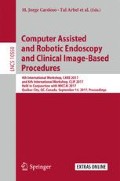Abstract
3D photography offers non-invasive, radiation-free, and anesthetic-free evaluation of craniofacial morphology. However, intracranial volume (ICV) quantification is not possible with current non-invasive imaging systems in order to evaluate brain development in children with cranial pathology. The aim of this study is to develop an automated, radiation-free framework to estimate ICV. Pairs of computed tomography (CT) images and 3D photographs were aligned using registration. We used the real ICV calculated from the CTs and the head volumes from their corresponding 3D photographs to create a regression model. Then, a template 3D photograph was selected as a reference from the data, and a set of landmarks defining the cranial vault were detected automatically on that template. Given the 3D photograph of a new patient, it was registered to the template to estimate the cranial vault area. After obtaining the head volume, the regression model was then used to estimate the ICV. Experiments showed that our volume regression model predicted ICV from head volumes with an average error of 5.81 \( \pm \) 3.07% and a correlation (R2) of 0.96. We also demonstrated that our automated framework quantified ICV from 3D photography with an average error of 7.02 \( \pm \) 7.76%, a correlation (R2) of 0.94, and an average estimation error for the position of the cranial base landmarks of 11.39 \( \pm \) 4.3 mm.
Access this chapter
Tax calculation will be finalised at checkout
Purchases are for personal use only
References
Anderson, P.J., Netherway, D.J., Abbott, A., David, D.J.: Intracranial volume measurement of metopic craniosynostosis. J. Craniofac. Surg. 15(6), 1014–1016 (2004)
Paniagua, B., Emodi, O., Hill, J., Fishbaugh, J., Pimenta, L.A., Aylward, S.R., Andinet, E., Gerig, G., Gilmore, J., van Aalst, J.A., et al.: 3D of brain shape and volume after cranial vault remodeling surgery for craniosynostosis correction in infants. In: Proceeding of SPIE Medical Imaging, 2013, vol. 8672, p. 86720V (2013)
Mendoza, C.S., Safdar, N., Okada, K., Myers, E., Rogers, G.F., Linguraru, M.G.: Personalized assessment of craniosynostosis via statistical shape modeling. Med. Image Anal. 18(4), 635–646 (2014)
Prastawa, M., Gilmore, J.H., Lin, W., Gerig, G.: Automatic segmentation of MR images of the developing newborn brain. Med. Image Anal. 9(5), 457–466 (2005)
Ezaldein, H.H., Metzler, P., Persing, J.A., Steinbacher, D.M.: Three-dimensional orbital dysmorphology in metopic synostosis. J. Plast. Reconstr. Aesthetic Surg. 67(7), 900–905 (2014)
Rodriguez-Florez, N., Göktekin, Ö.K., Bruse, J.L., Borghi, A., Angullia, F., Knoops, P.G., Tenhagen, M., O’Hara, J.L., Koudstaal, M.J., Schievano, S., et al.: Quantifying the effect of corrective surgery for trigonocephaly: a non-invasive, non-ionizing method using three-dimensional handheld scanning and statistical shape modeling. J. Cranio-Maxillofacial Surg. 45(3), 387–394 (2017)
Wilbrand, J.-F., Szczukowski, A., Blecher, J.-C., Pons-Kuehnemann, J., Christophis, P., Howaldt, H.-P., Schaaf, H.: Objectification of cranial vault correction for craniosynostosis by three-dimensional photography. J. Cranio-Maxillofacial Surg. 40(8), 726–730 (2012)
Meulstee, J.W., Verhamme, L.M., Borstlap, W.A., Van der Heijden, F., De Jong, G.A., Xi, T., Bergé, S.J., Delye, H., Maal, T.J.J.: A new method for three-dimensional evaluation of the cranial shape and the automatic identification of craniosynostosis using 3D stereophotogrammetry. Int. J. Oral Maxillofac. Surg. 46(7), 819–826 (2017)
Freudlsperger, C., Steinmacher, S., Bächli, H., Somlo, E., Hoffmann, J., Engel, M.: Metopic synostosis: Measuring intracranial volume change following fronto-orbital advancement using three-dimensional photogrammetry. J. Cranio-Maxillofacial Surg. 43(5), 593–598 (2015)
Lorensen, W.E., Cline, H.E.: Marching cubes: A high resolution 3D surface construction algorithm. Comput. Graph. (ACM) 21(4), 163–169 (1987)
Porras, A.R., Zukic, D., Equobahrie, A., Rogers, G.F., Linguraru, M.G.: Personalized optimal planning for the surgical correction of metopic craniosynostosis. In: Shekhar, R., Wesarg, S., González Ballester, M.Á., Drechsler, K., Sato, Y., Erdt, M., Linguraru, M.G., Oyarzun Laura, C. (eds.) CLIP 2016. LNCS, vol. 9958, pp. 60–67. Springer, Cham (2016). doi:10.1007/978-3-319-46472-5_8
Besl, P., McKay, N.: A method for registration of 3-D shapes. IEEE Trans. Pattern Anal. Mach. Intell. 14(2), 239–256 (1992)
Rueckert, D., Sonoda, L.I., Hayes, C., Hill, D.L.G., Leach, M.O., Hawkes, D.J.: Nonrigid registration using free-form deformations: application to breast MR images. IEEE Trans. Med. Imaging 18(8), 712–721 (1999)
Bland, J.M., Altman, D.: Statistical methods for assessing agreement between two methods of clinical measurement. Lancet 327(8476), 307–310 (1986)
Acknowledgements
This work was partly funded by the National Institutes of Health, Eunice Kennedy Shriver National Institute of Child Health and Human Development under grant NIH R42HD081712.
Author information
Authors and Affiliations
Corresponding author
Editor information
Editors and Affiliations
Rights and permissions
Copyright information
© 2017 Springer International Publishing AG
About this paper
Cite this paper
Tu, L. et al. (2017). Intracranial Volume Quantification from 3D Photography. In: Cardoso, M., et al. Computer Assisted and Robotic Endoscopy and Clinical Image-Based Procedures. CARE CLIP 2017 2017. Lecture Notes in Computer Science(), vol 10550. Springer, Cham. https://doi.org/10.1007/978-3-319-67543-5_11
Download citation
DOI: https://doi.org/10.1007/978-3-319-67543-5_11
Published:
Publisher Name: Springer, Cham
Print ISBN: 978-3-319-67542-8
Online ISBN: 978-3-319-67543-5
eBook Packages: Computer ScienceComputer Science (R0)

